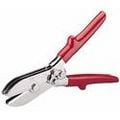Sunny Brae rainwater catchment system
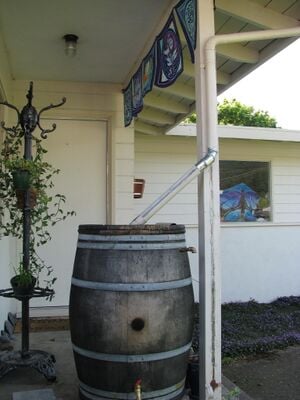
We are iving in a world with an ever increasing human population. This is increasingly putting stress on the limited resources available to all beings of this Earth. Steps must be taken to increase self sufficiency in all aspects of our lives. One common factor that unites all beings on this Earth is the need for water. And in the end, all water across Earth has either been at some point or currently is in the form of rainwater. Whether the source originates from an aquifer, a city water treatment plant, a river, or a well, the water was at one point in the sky cloud-bound before it was rained down upon the ground. Rainwater can be used for landscaping, irrigating, livestock water, drinking and bathing. Rainwater catchment systems can be as simple as diverting a small rain stream on a surface to a catchment tank or as intricate and complex as an industrial system used for collecting drinking water. Regardless of the level of design, by utilizing this appropriate technology one is taking advantage of the forces of Nature, in this case rain, to work in their favor to capture cheap and clean water.
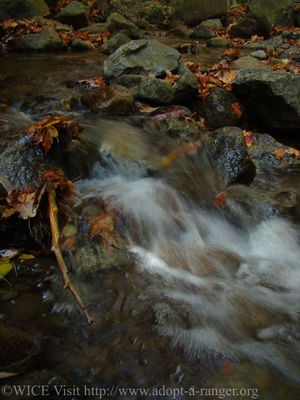
The 5 W's[edit | edit source]
WHO : The clients who I worked with on this project were Juliana and Brad Dixon. Juliana attended Cal Poly Humboldt where she received her degree in Environmental Science in 2006. She was the 'Green Team' coordinator for Starbucks in the New England Region during 2002-2003. She also is the founder of Home Green Home, a local community organization and resource dedicated to sharing knowledge about the environment and practices to help reduce our global and local foot print so that we all may help each other as a community to take on this task of saving ourselves and this world. Brad also attended Humboldt State where he received his degree in Communications in 2008. Currently, he is in the process of starting his own business, a snow cone shop. All of his ingredients will be organic, he will not use any sugar, and he will attempt to use all local ingredients. Brad also took Engineering 305 at HSU where he used old rubber tires to create tire shingles.
WHAT: The objective of this project is to construct and install a residential rainwater catchment system at the Dixon House.
WHERE: The house is located in Sunny Brae, California. Here is a link to an interactive map of Sunny Brae and Bayside, California.
WHEN: This project too place during the spring of 2010.
WHY: Being the founder of Home Green Home, this is yet another example that Juliana can set for the community. It is an easy yet environmentally smart and economically viable option that people can use to reduce their impact on the environment. With the pressing issue of water and the increasing demand on the global water supply, conserving water and more effectively utilizing the natural resources around us without the use of industrial systems are reasons why this rainwater catchment system makes sense. Rain water can be collected and used for irrigation and for flushing toilets.
Research[edit | edit source]
System Components[1][edit | edit source]
The basic components of a rainwater catchment system are:
- Catchment surface
The most common types of catchment surfaces are metal roofs, clay and/or concrete tile, composite shingle, wood shingle, tar and gravel, and slate. Because of the chemicals used on much of these surfaces, the water collected from these systems is appropriate only for nonpotable uses such as irrigation, bathroom use, and small home greywater marshes. The water quality also depends on other factors besides the roof catchment of the local climate and the immediate, surrounding environment.
- Gutters and Downspouts
The gutters and downspouts are responsible for collecting the rain that runs off the roof and then transporting this water to the catchment tanks. PVC piping, vinyl, metal piping, galvanized steel, aluminum, wood, and bamboo are some of the most widely used materials for the gutters. Several factors to keep in mind when looking at the gutter and downspout aspect of the rainwater catchment system are having an adequate amount of downspouts, the steepness of the slope of the roof, and maintenance of the gutters. Having an inadequate amount of downspouts, too steep of a pitched roof, and improper maintenance of the gutters will result in an overflow of rainwater from the gutters. Not having enough downspouts prevents the water from draining fast enough into the tanks and will cause a back-up at these points and eventually cause the water to overflow. With too steep of a pitch, the rainwater will just come rushing down the specific rooftop and splash out of the gutters. And not properly maintaining and cleaning out the gutters creates a build up of debris and other materials causing the gutters to have a restricted flow and overflowing.
- First flush system and leaf and debris filters
The type of filters and the need for a first flush system depends largely on the area and use of the catchment system. Because some areas are more prone to debris build up, dust and leaf accumulation, and flora matter, the type of method used to filter the system will be completely different than other areas. In general, an average wire screen of 1/4 to 3/4 inch is a good leaf and large debris filter for the downspout areas and a finer mesh or screen filter should be closer to the catchment tank in the downspout. The first flush system is very crucial for many parts of the world. The concept behind the first flush system is that the roof surface is a good area for the accumulation of debris, dust, animal feces, pesticides, toxic chemicals, and other airborne particulates. Because it is such a good collection area for all this matter that we do not want in our water, the first flush system diverts some initial amount of water out of the collection tank to help with the removal of these particles. There is, however, lots of controversy about the specific volume and time alloted for the first flush system. Despite this, in general, a good guideline to follow for first flush systems is about 10 gallons for every 1000 square feet of roof surface.
- Catchment tank
The main point of the catchment tank is to store and collect the water. Because of this, one wants to place the catchment tank as close to the source of rainwater supply and as close to the areas that demand the rainwater. For practical purposes, the tank should be placed higher to assist gravity in its task of helping to transport the collected rainwater to specific areas of an area. Another accepted practice of tank placement is to have it in an area where it does not receive direct sunlight if all possible. If not, some type of shading would greatly benefit the durability of the catchment tank because it will not have the intense exposure to the sun which would photodegrade the tank and shorten its lifespan. Because water is so heavy, weighing about 8 pounds per gallon of water, with a tank sized at 1000 gallons, the weight of the tank when full is around 8,000 pounds! It is crucial to place the tank on level, stable ground, whether it be a pre-constructed pad or on soil. Another component of the catchment tank is the overflow valve. In some cases and areas, a heavy rain will occur and the tank will become rapidly filled and the water can then become back-filled in the downspout. To help with situations like this, a downspout helps to easily solve this dilemma. One important thing to note about the downspout is to place it in an area where the overflowing water will not cause soil erosion and changing the soil pad. Because water can cause erosion and shifts in the soil layers, one must put some time and thought into this placement. Another option too is to have the overflow water diverted to a flower bed, small marsh, crop fields, or just simply away from the catchment pad.
- Treatment and Purification
For people interested in using their water for potable uses, a treatment and purification system need to be implemented. The most common types of water treatment for rainwater catchment systems are ultraviolet light, ozone, reverse osmosis, activated charcoal, and chlorination. Most of these processes are very energy intensive and require a constant power source, thus most of the systems that incorporate these purification systems are in highly developed and industrial areas.
Catchment Surface Collection Calculation[edit | edit source]
Appropedia has a very appropriate page dedicated to rainwater calculations.
Arcata Precipitation Data[edit | edit source]
Average Precipitation for Arcata, California[2]
| January | February | March | April | May | June | July | August | September | October | November | December | Annual |
|---|---|---|---|---|---|---|---|---|---|---|---|---|
| 5.97 in. | 5.51 in. | 5.55 in. | 2.91 in. | 1.62 in. | 0.65 in. | 0.16 in. | 0.38 in. | 0.86 in. | 2.36 in. | 5.78 in. | 6.35 in. | 38.10 in. |
Design[edit | edit source]
One of the main concerns the client had about the entire project was the use of plastics. Because of their conscious views and wanting to be as sustainable and environmentally aware as they can, they did not want to have any plastic, if possible, in the entire system. Numerous studies and research have been conducted on plastics and have concluded that plastics leach toxic and harmful chemicals for both the environment and all organisms. With this added constraint, more research and outside of the box thinking were required to come up with alternatives to the easily and readily available plastic resources. After much consideration and time dedicated to figuring out what route to take, we decided to keep the original wood gutters of the house because this would accomplish two tasks: remove the usage of plastic for the gutters and reduce the initial cost of the project.
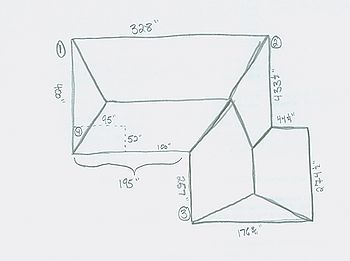
Criteria[edit | edit source]
After further research into rainwater catchment systems and meeting with the client to discuss specific interests and wants for this project, the criteria were created.
| Criteria | Constraint | Weight |
|---|---|---|
| Maintainability | <2 human hours of work per week | 7 |
| System Efficiency | Catches 80% of rainfall runoff | 10 |
| Level of Applicability | Able to pump and transport water into bathroom and for irrigation use | 5 |
| Level of Material Appropriateness | As chemical, plastic, and health pollutant free for both human ingestion and the environment | 7 |
| Cost | Less than $200 | 9 |
| Level of Water Potability | Clean and sanitary enough for bathroom and irrigation use. | 5 |
| Level of Embedded Energy | Materials used for system are within 100 miles of project location. | 8 |
| Durability | Lifespan of system = ~ 5-10 years | 6 |
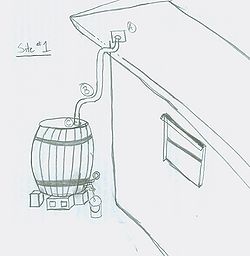
System Design[edit | edit source]
This is a table of the different types of tanks that are commercially available for both potable and non potable uses of rainwater:
| TYPE OF TANK | DESCRIPTION |
|---|---|
| Galvanized Steel | Most common material for cistern, sized up to 3,000 gallons, good to have epoxy based liner/sealer. |
| Concrete | Normally built on-site, can be used as secondary use of thermal storage for buildings |
| Ferrocement | Made using a cement plaster over a wire mesh form. One of cheapest options for cistern. |
| Mortated Stone | Traditional practice used for cisterns. Very high construction and labor cost, but very pleasing aesthetic value. |
| Fiberglass | Inexpensive, very lightweight, larger sizes available up to 10,000 gallons. |
| Polyethylene | Lightweight, low maintenance, easy to transport and move around, can be used above or below ground |
| Durable Wood | Very durable, recycled materials can be used, redwood or cypress can be used. Does not degrade with sun. |
Tank Choice
After making several assumptions about the entire system, we decided to go with wine barrels. Because there are several wineries around the area, I thought it would be a cool idea to try and utilize recycled wine barrels for the collection tanks. As well as trying to use recycled materials, this would also appeal to the criterion of level of embedded energy. We finally decided upon 3 55 gallon barrels and 1 59 gallon barrel totaling in 224 gallons for the total holding capacity of the system. The reason all four of the wine barrels are not equal volumes is that two of the wine barrels were donated and I did not want to turn away anything I could get for free. We assumed that with four of the eight downspouts being used for the system, the holding capacity would not need to be so large because there would only be a certain percentage of all the rain being diverted to collection tanks.
Construction[edit | edit source]
After all the research and planning had been done, it was time to move to the action stage.
Construction Process[edit | edit source]
Wine Barrel Foundation
-
Figure 1: Rinsing the barrel to clean out all debris, old wine, and anything else to get it as clean as can be!
-
Figure 2: Preparing the ground site for the location and placement of the wine barrel.
-
Figure 3: Cutting wood for platform for one of one barrel locations.
-
Figure 4: Making sure that the ground is level after preparing for placing the wine barrel.
Wine Barrel Preparation
-
Figure 5: Drilling the downspout hole into the top of the wine barrel.
-
Figure 6: Drilling the overflow hole into the side of the barrel.
Downspout Preparation
-
Figure 7: Fitting and finding appropriate length of gutter from downspout on eave to wall of house.
-
Figure 8: Sawing the gutter into proper length to fit the system requirements.
-
Figure 9: Crimping the gutter so it can fit into other gutter to gutter connections. A crimping tool allows gutters with the same diameter to fit into each other at the altered end.
-
Figure 10: Fitting the crimped gutter into the first downspout.
-
Figure 11: Climb up onto roof to access downspout safely.
-
: Figure 12: Attaching the debris filter to the downspout hole.
-
: Figure 13: Last stage, screen successfully attached, completed before attaching wine barrel!
-
Figure 14: Vuala! You have yourself one of four collection sites of the entire rainwater catchment system!
Materials and Cost[edit | edit source]
Budget
| Qty | Material Needed | Source | Cost | Total cost |
|---|---|---|---|---|
| 1 | 55 gallon wine barrel | Winnett Vineyards | $60 | Donated |
| 1 | 59 gallon wine barrel | Winnett Vineyards | $60 | Donated |
| 2 | 55 gallon wine barrels | Moonstone Crossing Winery | $30 | $60 |
| 4 | Cinder Blocks | Ace Hardware | $3.59 | $15.65 |
| 8 | Red deco blocks | Resale Lumber Products | $2.80 | $24.25 |
| 4 | Brass Nipple 3/8" x 1/2" | Ace Hardware | $5.49 | $21.96 |
| 4 | 3/8" Brass 90o Elbow | Ace Hardware | $4.99 | $19.96 |
| 4 | 1/2" Brass Hose Bibb | Ace Hardware | $6.99 | $27.96 |
| 2 | Plugs | Ace Hardware | $3.40 | $6.80 |
| 1 | 5 Blade Crimper | Ace Hardware | $21.99 | $21.99 |
| 1 | Lexel Clear Caulking | Ace Hardware | $8.49 | $8.49 |
| 1 | Hacksaw Blade | Ace Hardware | $3.99 | $3.99 |
| 4 | 2" Adjusting Round Elbows | Ace Hardware | $3.95 | $15.80 |
| 4 | Clamps | Ace Hardware | $1.79 | $7.16 |
| 4 | Hose clamps | Ace Hardware | $1.79 | $6.44 |
| 1 | Wire cloth 1/8" | Ace Hardware | $1.90 | $1.90 |
| 1 | 2" Galvanized steel downspout-10' in length | Ace Hardware | $8.09 | $8.09 |
| 2 | Garden 2-way hose adapter | Harbor Freight Tools | $4.49 | $8.98 |
| 1 | Water Pump | Harbor Freight Tools | $25.99 | $25.99 |
| 1 Box | screws, washers, nuts, nails | Home | $Free | $0.00 |
| Total Cost: | $285.41 |
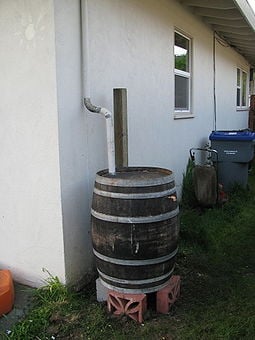
Tools Required
For this project, only a basic background and knowledge of construction techniques are necessary; however, creative thinking is a must.
- Power drill
- Forstner drill bits-these were used to make the downspout and overflow holes
- Philips and Flathead screwdriver
- Hammer
- Hand saw
- Hack saw
- Level
- Staple Gun
- Crimper
-
Figure 15:An example of a crimper tool
Testing[edit | edit source]
After completing the entire construction process, the system had to be tested to ensure that this appropriate technology actually works appropriately. The construction stage was completed on April 19, 2010. Two hours after all of the wine barrels were connected to the downspouts, it began to rain. Once the brief moment of raining passed, a very nice result was waiting for me at the Sunny Brae house: the system was successful!
With only the first rain, all of the wine barrels caught and held rain!
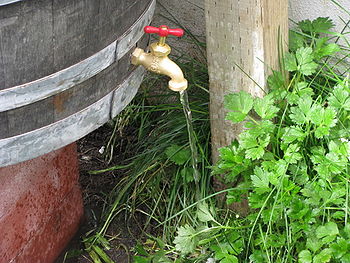
Despite this, there were several unexpected, yet always occuring, glitches that needed to be fixed. The first problem with the system was that the downspout gutters were not installed properly. The adjusting round elbows were placed on the inside of the gutters
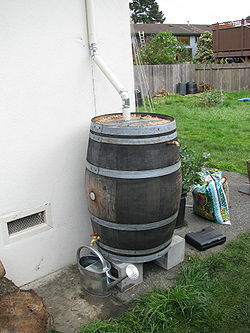
instead of having the downspout go into the elbow. With that design, the rainwater flowing down the downspout could escape and drain out because of the fact that the downspout connection to the elbow was on the outside instead of inside the elbow. Fixing this glitch helped to remedy the problem of the rainwater escaping and not being captured. The other problem with the system was at the downspouts on the roof. Because of their roof surface being composite shingle there is a lot of debris and small particles that collect and are transported by the rain to these downspout holes. With the leaf and debris screen installed, the first rain brought about a problem. At these downspout holes too much small debris was collected and caused the rainwater to overflow and drain off the roof, not being captured in the collection tanks. To help fix this problem, I decided to alter the leaf and debris screens. Instead of having them attached flat on the roof, I cut squares of the wire screen and made a round screen filter that fits vertically into the downspout. This alternative design to the original really helped out to fix the problem of overflowing. Because the debris no longer collected on top of the filter and caused a back flow of the water the system functioned more efficiently and properly now by catching the rainwater and diverting the debris out of the system.
Once these two necessary adjustments had been made to the design, the system was tested again. This time, I used a hose and sprayed water onto the roof to mimic a small rain. Despite my uncertainty in the system, it successfully captured all the water that entered the downspout and diverted the debris that was collected from the water.
Although this second trial proved to be a success, there was one main problem with the system: there was not enough storage capacity for the system and there was not adequate usage of the water being stored. Because the system is being used for household toilet water and watering plants outside, the rate at which the captured water was being consumed was not fast enough to keep up with the rains of April, 2010, and this resulted in some overflow onto their lawn. Sitting down and doing back to the drawing board, we decided to get a larger holding tank, this time being a polypropylene tank. We decided to go with a plastic catchment tank with a larger capacity because of the cost issue. Even though the client was very stern and particular about not using any plastic, we felt that at this point with all the other stages where we avoided plastics, we would have to compromise on this one point and go with the larger polypropylene catchment tank.
Infrastructure[edit | edit source]
Necessary Maintenance for upkeep of the system:
→Clean area around the downspout screens about once a week. Depending on the intensity of the rains, it might be appropriate to clean the screens with a heavy downpour.
→Flush the catchment barrels once every 6 months. Because some smaller particles, dust, and debris will enter the system and not get caught by the filters, it would be smart to clean out the barrels.
- Disconnect the barrel from the downspout.
- Turn the barrel on its side and attach a hose to the nozzle of the barrel.
- Blast water in hose for about 30 seconds.
- Rotate the barrel after water is inside to loosen up all the collected debris.
- Empty out the water and debris out through the exit hole of the barrel.
- Reconnect the barrel to the downspout.
→Check the downspout connections to ensure they are properly secured and not leaking in any areas.
The Future of this Project[edit | edit source]
The main criteria for this project was for the rainwater catchment system to actually collect and catch rainwater. Thankfully, this task was successfully completed. However through the design process and brainstorming with the client, we decided to attempt to connect the wine barrels to the toilet and use a hand pump to pump water from the barrels into the toilet for bathroom use instead of using Arcata city water, if all possibly avoidable. For the timeframe of this project and class, this aspect of the project was not completed. But....the ball continues to roll. Over the summer, I will be working with Brad to devise an efficient and appropriate design for connecting the barrels and the larger catchment tank to the toilet. Looking even more into the future, Brad and Juliana are really interested in creating a permeable driveway and utilizing some of the rainwater as the source of water for the driveway.
Discussion[edit | edit source]
I would like to offer the opportunity for yourself to give suggestions or alterations which you feel would benefit this project. Please post any questions or comments in this section.
Acknowledgements[edit | edit source]
I would like to thank Ramon Escobar for the work he volunteered to help me complete the construction stage of the project. Without his help, I would have been a lot more busy trying to do everything myself. I also would like to thank Winnett Vineyards for their kind donation of the two wine barrels. This made my task of finding an alternate and recycled resource for the catchment tank.
Literature Review[edit | edit source]
- Cullis, Adrian, and Arnold Pacey. Rainwater Harvesting: The Collection of Rainfall and Runoff in Rural Areas. London: Intermediate, 1986.
- Very informative book dealing with the construction of the catchment systems. Many illustrations helping to explain many questions I had.
- "Daycare rainwater catchment system - Appropedia: The sustainability wiki." Appropedia. https://www.appropedia.org/Daycare_rainwater_catchment_system (accessed February 9, 2010).
- Good example of implemented rainwater catchment system. Too small yet expensive for the scope of this project. Good baseline to get info from.
- Gertson, Jan. "Rainwater harvesting: a new water source." Texas Water Savers 3, no. 2 (1997): 1-14.
- Gives a detailed report on how to collect residential rainwater and also details a little about roof rainwater contamination.
- Gould, John E.. Rainwater Catchment Systems for Household Water Supply. Bangkok: Asian Institute of Technology, 1991.
- Very, very useful book that goes into much detail about the entire system of rainwater catchment.
- Gould, John, and Erik Nissen-Petersen. Rainwater Catchment Systems for Domestic Supply: Design, Construction and Implementation. London: Practical Action, 2000.
- Yet another good source by Gould. Not as informative as the previous source but very useful regardless.
- Lye, Dennis J.. "Health Risks Associated with Consumption of Untreated Water From Household Roof Catchment Systems." Journal of the American Water Resources Association 38, no. 5 (2002): 1301-1306.
- Discusses the contaminated water from rooftops and how it can affect humans and our health.
- "M Street Eureka rainwater catchment - Appropedia: The sustainability wiki." Appropedia. https://www.appropedia.org/M_Street_Eureka_rainwater_catchment (accessed February 9, 2010).
- Very good reference as well a current, operating catchment system I can observe and modify to adapt to my project.
- Nagy, Erik M.. An Analysis of Three Slow-Sand Rooftop Rainwater Catchment System Filters. Arcata: Cal Poly Humboldt, 1997.
- Details three different filtration systems that filter rooftop rainwater. Also very good reference for out-of-state and other contacts to pursue more information from.
- "NSF Consumer Information: Home Water Treatment Devices." NSF International. http://www.nsf.org/consumer/drinking_water/dw_treatment.asp?program=WaterTre#treatment (accessed February 12, 2010).
- Compares the different type of home water devices there are to treat water, and can be applied to rooftop rainwater catchment.
- "Rainwater Catchment." Appropriate Technology Projects. http://www.pequals.com/at/riodell_rainwater/index.html (accessed February 12, 2010).
- Rainwater catchment system in Rio Del, California. Going to visit the location this upcoming week to investigate failures and successes of project.
- Rainwater Catchment System - Appropedia: The sustainability wiki." Appropedia. https://www.appropedia.org/Rainwater_Catchment_System (accessed February 12, 2010).
- Very useful informative site about the basics and necessities of a rainwater catchment system.
- Run-off rainwater harvesting - Appropedia: The sustainability wiki." Appropedia. https://www.appropedia.org/Run-off_rainwater_harvesting (accessed February 12, 2010).
- Another informative site than can be referenced to for many questions and gives the basics of a catchment system.
- Simmons, Greg, Virginia Hope, John Whitmore, Gillian Lewis, and Wanzhen Gao. "Contamination of potable roof-collected rainwater in Auckland, New Zealand." Water Research 35, no. 6 (2001): 1518-1524.
- Investigates microbial and chemical contaminants in four different locations in New Zealand.














